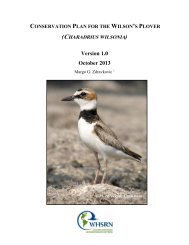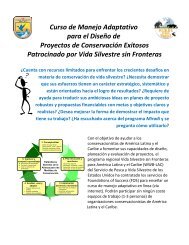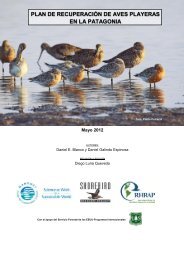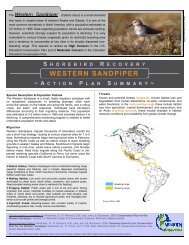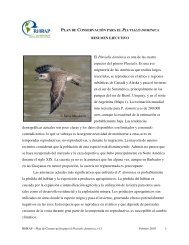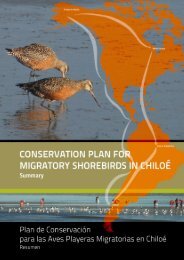Sanderling Plan - Western Hemisphere Shorebird Reserve Network
Sanderling Plan - Western Hemisphere Shorebird Reserve Network
Sanderling Plan - Western Hemisphere Shorebird Reserve Network
Create successful ePaper yourself
Turn your PDF publications into a flip-book with our unique Google optimized e-Paper software.
Nunavut (near Nanisivik, Strathcona Sound; Godfrey 1986). In mainland Canada, <strong>Sanderling</strong>s<br />
breed on Boothia and Melville Peninsulas, and Southampton Island, Nunavut; they rarely breed<br />
in the Northwest Territories (Bathurst Peninsula, Franklin Bay; MacWhirter et al. 2002) (Figure<br />
1).<br />
Nonbreeding Range<br />
In the summer, nonbreeding birds occur south of the breeding range (Figure 1).<br />
During migration: Despite their broad winter distribution and locally modest numbers,<br />
<strong>Sanderling</strong>s are quite aggregated during spring migration, relying on several major staging areas<br />
to complete their lengthy migrations to the high arctic. Major North American staging areas<br />
include the outer coastal sandy beaches of southern coastal Washington to central Oregon<br />
(Myers et al. 1984b, 1984b), and (possibly) Prince William Sound, Alaska, on the Pacific Coast;<br />
alkaline lakes in interior Saskatchewan, Canada (Beyersbergen and Duncan 2007, Beyersbergen<br />
unpubl. data); and Delaware Bay—especially the lower New Jersey region (Dunne et al. 1982,<br />
Clark et al. 1993) and the central coast of North Carolina (Dinsmore et al. 1998, Walters 1984)<br />
on the Atlantic Coast. Smaller numbers of <strong>Sanderling</strong>s also consistently stop on migration<br />
throughout the Texas Gulf coast and Florida.<br />
Less is known about <strong>Sanderling</strong> distributions on migration in South America. However,<br />
surveys indicate that Lagoa do Peixe, Brazil, is a major staging area in spring (Morrison and<br />
Ross 1989), and that birds use the Pacific and Atlantic coastlines of South America during both<br />
migrations.<br />
During fall migration, <strong>Sanderling</strong>s are more dispersed in North America, using both<br />
Pacific and Atlantic coastlines, to a lesser extent, the U.S. and Canadian interior. In the United<br />
States, they occur in the thousands in New Jersey (Burger et al. 1977), Massachusetts, the Outer<br />
Banks of North Carolina (Dinsmore et al. 1998, Myers 1988), Virginia, Texas, and Washington<br />
(MacWhirter et al. 2002, and ISS data), and in Saskatchewan, Canada (Beyersbergen and<br />
Duncan 2007, Beyersbergen 2009); they occur in the hundreds in many other locations.<br />
Wintering grounds: The majority of <strong>Sanderling</strong>s that breed in North America winter in Central<br />
and South America between the latitudes of the Tropics of Cancer (23.5 o N) and Capricorn<br />
WHSRN – <strong>Sanderling</strong> Conservation <strong>Plan</strong>, February 2010, v1.1 15





